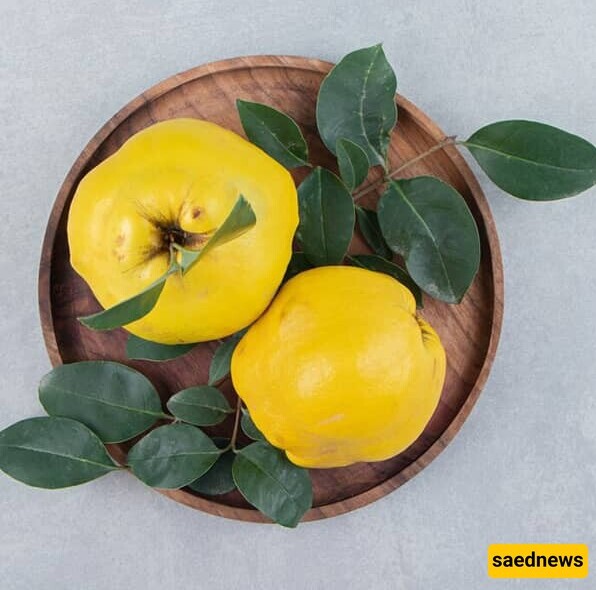Saed News: One of the most delicious and aromatic fruits is quince, which offers numerous benefits and advantages.

According to the Family Magazine Service of Saed News, quince, scientifically known as Cydonia oblonga, is a yellow, medium-sized, fragrant fruit. It is available in the fall and winter seasons and is used in the preparation of certain dishes such as various stews, quince tea, and quince jam. It is rarely consumed raw.
As reported by Imna, quince contains carbohydrates, protein, pectin, dietary fiber, and vitamins A, B, and C, along with minerals such as calcium, copper, iron, magnesium, phosphorus, and zinc. Due to its vitamin C content and phenolic compounds, it is considered a natural antioxidant.
1. Select Quince: Choose a few medium-sized quinces (the quantity can vary as needed). Ensure the quince has a fully yellow skin so you don’t need to peel them for making the tea.
2. Wash and Grate: Wash the selected quinces thoroughly to remove their fuzz. Then, use a julienne grater to shred them into thin strips.
3. Drying the Grated Quince: Dry the grated quince strips at a low and consistent temperature. The best way to do this is by spreading the strips in a container and placing them on a low-heat radiator or heater.
4. Roasting the Strips: Once the strips are completely dried, roast them to enhance their flavor. Place a pan on the stove over high heat until it is hot, then add the dried quince strips. Stir them continuously until their color turns deep brown.
5. Brewing the Tea: Add one tablespoon of the roasted quince strips for each person into a teapot. For each person, add one cup of boiling water. Cover the teapot with a cloth and let the tea brew on very low heat for 15 minutes.
6. Storing the Leftovers: Store the remaining roasted quince strips in a sealed plastic or glass container for future use.
Enjoy a warm and aromatic quince tea, perfect for autumn and winter days!

Warm to Moderate Nature of Quince
Quince is a fruit with a warm to moderate nature, making it suitable for people with various temperaments. This yellow fruit, with a dry and fuzzy texture and a tart, astringent taste, belongs to the same family as apples and pears. Major producers of quince include Turkey, China, Uzbekistan, Iran, Argentina, and some southern European and southwestern Asian countries.
How to Consume Quince
Due to its high pectin content, quince is often used in making jam, marmalade, or compote. It can also be cooked in stews, which softens and enhances its flavor. Another way to enjoy quince is by roasting it in the oven and preparing tea or infusions. Quince can also be used in pies, tarts, and muffins, just like apples and pears. It can be consumed raw as well.

Anti-Inflammatory Properties
Quince is a rich source of vitamin C, providing about 25% of the daily recommended intake. Vitamin C boosts the immune system and helps treat various inflammatory conditions. It also has anti-allergy properties.
Rapid Weight Loss and Reduction
Quince is a low-calorie fruit but rich in dietary fiber. 100 grams of fresh raw quince contains about 57 calories. It is also low in saturated fat, sodium, and cholesterol, making it an excellent choice for weight loss and overall health.
Treatment for Stomach Issues
Quince is an effective remedy for morning sickness and digestive discomfort. When mixed with honey, it can help treat colitis, diarrhea, constipation, and intestinal infections.
Antioxidant Properties of Quince
Thanks to its polyphenolic compounds, quince has powerful antioxidant properties. These antioxidants fight free radicals in the body, slow down aging, and help prevent cardiovascular diseases and strokes.
Relieving Nausea and Vomiting
Cooked or boiled quince can alleviate nausea and vomiting. As a good diuretic, it helps the body eliminate toxins and excess fluids.
Antiviral Properties
Quince is rich in antiviral properties. The phenolic compounds in quince have strong antiviral activity and antioxidant properties, offering protection against colds and other viral diseases.
Blood Pressure Reduction
Due to its potassium content, quince helps regulate and lower high blood pressure.
Reducing Cholesterol Levels
Regular consumption of quince can help reduce LDL (bad cholesterol) levels in the blood, keeping the heart healthy.
Anti-Cancer Properties
The antioxidant properties of quince help the body resist free radicals and cancer cells. Quince also contains tannins, which protect mucous membranes from cancer and eliminate chemicals and toxins that cause colon cancer.
Stress Relief
The various antioxidants in quince help reduce stress and maintain a calm mind.
Quince in Pregnancy
Quince and quince tea offer numerous benefits during pregnancy. Quince is rich in vitamin B6, which helps alleviate pregnancy-related nausea and vomiting. It is especially recommended for pregnant women between the sixth and fourteenth weeks of pregnancy.
Benefits for the Fetus
Quince has a beneficial impact on the IQ of newborns, potentially enhancing children’s intelligence. Some studies have also highlighted the effects of quince on children's beauty.
Skin Health and Vitality
One of the benefits of quince is its effect on skin health and vitality. It contains antioxidants that help eliminate harmful factors for skin health, reducing wrinkles and skin blemishes. Quince also helps protect the skin from harmful ultraviolet rays.
Hair Health
Quince contributes to healthy, beautiful hair. It is beneficial for blood production, and by enhancing circulation and strengthening blood flow, it helps improve hair follicle strength, promoting hair growth and beauty.


